Road Salt
Understanding the Application of Road Salt in Winter Maintenance
Introduction
Winter brings with it the serene beauty of snow-covered landscapes, but also the treacherous hazard of icy roads, driveways, and pavements. One of the most common and effective methods to mitigate these hazards is the use of road salt. But what exactly is road salt, and how does it work to keep the roads safe during the icy winter months?
Often referred to as gritters, seen here spreading salt on a road in the UK
The Role of Road Salt in Winter Safety
Road salt is a critical component in ensuring the safety of highways, pavements, and drives during cold weather. When temperatures plunge, the risk of ice formation increases exponentially, posing a significant danger to motorists and pedestrians alike. Road salt, primarily composed of rock salt, is employed to either dissolve existing ice or preemptively prevent its formation.
Rock salt functions by lowering the freezing point of water. When applied before the onset of snow or ice, it inhibits the hard packing of snow and ice, effectively reducing accidents and ensuring smoother traffic flow. It is particularly potent when temperatures are just below freezing, making it a staple in winter maintenance especially in regions prone to chilly but not extreme cold conditions.
The Origin of Road Salt
The United Kingdom is home to extensive salt mines, with over 140 miles of tunnels stretching beneath the surface. Cheshire, County Antrim, and Teesside are regions particularly rich in salt deposits. Continuous miners equipped with rotating steel cutting picks extract the salt, which is then treated with anti-caking agents and stored for distribution.
There are different types of road salt available, each with its unique properties and applications:
Rock Salt (coarse and fine): Extracted from natural salt beds, this is the most common type of salt used for de-icing purposes.
Marine Salt (coarse): Imported from warmer countries, this salt is obtained through the solar evaporation of seawater, containing traces of natural sea water impurities.
Vacuum Salt (fine): This is pure salt obtained by the evaporation of brine under a vacuum.
Composition and Quality Assurance
To ensure the efficiency and safety of road salt, strict quality controls are in place. The salt is tested for storing quality, moisture content, grading by sieve analysis, chemical composition, chloride content, and soluble sulphate, in accordance with BS 3247, the UK specification for salt spreading on highways for winter maintenance.
The typical composition of road salt is high in soluble chloride compounds, low in soluble sulfate compounds, and low in insoluble material. This composition ensures its effectiveness in melting ice and snow while minimizing environmental impact.
READ ABOUT THE TOP 10 SALT MINES IN THE WORLD, CLICK HERE
Storage and Application
Road salt is stored on well-drained sites to maintain its quality and effectiveness. Precautions are taken to prevent it from becoming a nuisance or hazard to people, animals, or plant life.
The application of road salt is a delicate process. The particle size and the height at which it's released above the road surface influence its spread and effectiveness. Too small particles may not achieve a wide distribution, while oversized particles can lead to wastage. In cases of significant snow accumulation exceeding 50mm, ploughing is often done before applying the salt to ensure maximum effectiveness.
Grit box - often used to store de-icing salt at properties or business premises
Conclusion
The use of road salt is not just a common practice but a scientific approach to ensuring road safety during winter. With strict quality control measures, careful application techniques, and a variety of types to suit different conditions, road salt remains a crucial ally in combating the icy hazards that come with the beautiful but often treacherous winter landscape. While the focus here is on the practices in the United Kingdom, similar strategies are employed globally, tailored to the specific climatic and environmental conditions of each region.

